If you have difficulties viewing this email, please view online |
September 2013 |
|
| |
 |
|
| |
|

CEOs bring strong links to National Health IT Board
The successful implementation of the National Health IT Plan relies on strong regional leadership. This year the NHITB has benefitted from the engagement and leadership of the four district health board CEOs who are the information technology representatives for their regions. We are working closely with them to provide a consistent approach to the development of information systems capable of delivering real benefits to New Zealanders, both regionally and nationally. They are now attending Board meetings of the National Health IT Board (NHITB), and their insights and focus on developing regional capability is proving very valuable. These CEOs were formerly part of a DHB CEO Information Group which has been replaced with an ICT Implementation Group. This is made up of CIO and IT representatives from the four DHB regions, the Ministry of Health, and Health Benefits Limited. It has been established to increase the pace of implementation and the sharing of learnings about what works with eHealth projects.
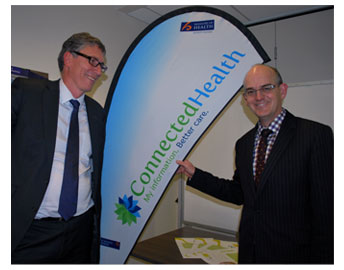
Graeme Osborne with Health Minister Tony Ryall
Strong leadership of this type lies behind the steady flow of benefits now emerging from initiatives such as electronic prescribing and administration (ePA), electronic referrals (eReferrals), and the development of secure online portals for clinicians to share information and patients to manage more of their own health care.
I was delighted to attend an event at Waitemata DHB with the Minister of Health, Tony Ryall, to celebrate the rollout of electronic prescribing and administration there, as well as the signing of a national contract to deliver the Medchart product. A major factor in the success of this project has been strong support from CEO Dr Dale Bramley, as well as the DHB’s clinicians. The Minister was also pleased to be involved in the launch of a new telehealth initiative in the Bay of Plenty, a clinician-led project which promises to improve health care for the people of Opotiki and surrounding areas.
Successes like these are beginning to attract international attention. For example, Queensland Health in Australia wants to better understand the approach we use to ensure effective implementation of eHealth solutions. It is particularly interested in how we are engaging stakeholders, including clinicians and the IT community in New Zealand, and we are looking forward to talking to them about the work we have underway and learning from their experiences in turn.
Securing national contracts is part of our drive for a consistent approach across information systems which may be designed nationally but implemented regionally or locally. Not all systems require a national contract but we are actively pursuing contracts for those systems that will benefit from national consistency and alignment. It’s about providing patients with the same high standard of care, wherever they live in New Zealand, support DHBs in the uptake of systems and solutions by removing barriers, and helping the sector maximise the value of its IT spend.
The challenge for us all now is to increase the pace of IT innovation and invest more in change management, which will lead to improvements in the quality and safety of health care. The National Health IT Plan, published in 2010 and currently being updated, is an important source of guidance for the sector about the priorities for investment. In effect it is a 'call to action' for clinicians and health leaders, and supports efforts to ensure the needs of consumers are at the heart of New Zealand’s health system and that consumers are involved in making decisions about the design and delivery of health IT services. The update of the Plan will provide greater detail about the work required over the next two years and beyond, and we will make this available for public feedback in the next month or so.
There is much still to do. At the same time we need to be mindful of security and privacy issues which have arisen elsewhere in the public sector, without letting the learnings from these slow down the drive for improvements in quality and safety which health IT can help to deliver. With that in mind, we are working closely with consumer and clinician groups, health provider organisations, government agencies and the Government’s CIO to ensure electronic systems are designed to be secure, reliable, relevant and respectful of people’s private information, and that access to information is authorised and transparent.
Graeme Osborne
Director
National Health IT Board
| |
|
|
| |
Clinician’s Corner –
Dr Sadhana Maraj
 |
Discussion at the eReferrals
workshop in Wellington. |
The sector is continuing to make good progress on improving electronic access to health information, and clinicians and patients are already benefitting.
The NHITB was pleased to support a visit by the Minister of Health recently to see electronic prescribing and administration of medicines (ePA) in action at Waitemata District Health Board. The DHB began rolling out ePA in some hospital beds late last year and health professionals there are seeing improvements in the legibility of prescriptions and electronic medical alerts. The Minister’s visit was an excellent opportunity to celebrate the progress that has been made in the national eMedicines programme in general, and in DHBs taking a lead with ePA (Southern, Taranaki and Waitemata) in particular. We are working toward all DHBs using ePA within the next couple of years.
The Minister also announced a national e-prescribing contract had been signed with an international information technology company, CSC. This will offer significant benefits to the sector by ensuring e-prescribing systems are consistent across the country, and it will encourage public hospitals to use e-prescribing by offering a competitive pricing package.
Added to that, we are seeing more and more uptake of electronic referrals, or eReferrals, around New Zealand. These help clinicians manage patient flow through the health system, from general practice to hospital and between other health providers, without relying on pieces of paper being sent to and arriving at the right destinations. With a touch of a button, a GP can fill out an eReferral form and send it to a hospital clinician for further assessment or treatment, which is obviously much quicker and more efficient than the old paper-based system.
Sixteen DHBs are now using eReferrals, and the others are in the process of introducing them. By 2014, we would like all DHBs to have a regional eReferrals system in place. More than 39,000 eReferrals were sent in May this year, which represents fantastic uptake by the sector.
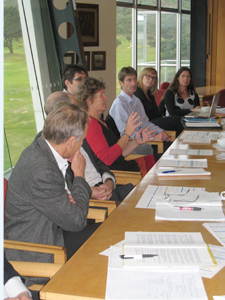 |
Discussion at the eReferrals
workshop in Wellington. |
As part of that work and supporting uptake, the NHITB hosted a small eReferrals workshop in Wellington in June to engage with clinicians and health leaders from primary and secondary care on the rollout of eReferrals. We had a very useful discussion about the impact of eReferrals on interoperability, costs, governance issues, clinical engagement, variability, benefit realisation, and standardisation. We also talked about how eReferrals might enable other initiatives and the relationship with clinical pathways and the national patient flow programme, as well as the challenges and opportunities that lie ahead. We will continue to meet and discuss these issues.
A key source of advice and input into all of the NHITB’s work, including the progress on shared care and patient portals, is the Consumer Panel. This group provides valuable consumer feedback to the NHITB and I am delighted to announce the appointment of a new Chair for the Panel, Stephanie Fletcher. Stephanie has been appointed for two years until July 2015. She brings a number of years of experience in consumer advocacy roles to her new position, and I look forward to working with her and the rest of the Panel.
Finally, the National Information Clinical Leadership Group (NICLG) met on 6 August. It had a full agenda and was focused on the themes of shared care. We had some very valuable presentations from clinicians, consumers and vendors which highlighted the importance of the shared care platform, especially for those consumers with long term conditions. Presentations on patient portals and clinical pathways encouraged good debate among NICLG members and added perspectives that will further support innovation in these areas.
Sadhana Maraj
eHealth Clinical Lead
Manager, Health IT Engagement
|
|
| |
|
|
| |
|
|
| |
|
|
| |
National Health IT Plan
The National Health IT Plan was published in 2010 to provide the health and disability sector with a coordinated view of the priorities for information technology investment. The Plan is now being updated to provide more detail about the priorities for the sector to the end of 2014 and beyond.
NHITB Director Graeme Osborne says the draft Plan will be available on the IT Board's website for public comment within a few weeks.
"The sector has made a significant amount of progress in the past three years and it's timely to focus now on the challenges and opportunities ahead of us in the period ahead," he says.
"This is about finding better ways to do things so that people using health and disability services benefit from improvements in quality and safety, and the efficient use of systems and resources."
He says the draft update to the IT Plan includes a stronger focus on the importance of involving service users in all aspects of their care, as well as the need to ground IT changes in the day-to-day realities of clinicians and service providers.
Achievements since 2010 include the development and/or implementation of:
- NZePS – community ePrescribing system
- a common system for hospital electronic prescribing and administration
- a shared care plan system for patients with long-term conditions
- a new Health Identity Platform to support patient and provider identifiers
- the Maternity Information System Programme
- the national Cardiac Health programme
- GP2GP, to transfer structured patient files from one GP system to another electronically
- Telehealth initiatives supported by the national Telehealth Forum.
|
|
| |
|
|
| |
| |
|
|
| |
In this issue...
Highlights
Consumer involvement in health care decisions
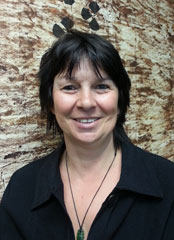
Stephanie Fletcher
The need for consumer involvement in health care decisions was driven home to Stephanie Fletcher when her father was diagnosed with bowel cancer and also suffered a stroke leaving him unable to communicate in 2004.
"Mum and I cared for Dad at home and I was astounded by the lack of involvement we had in the decisions being made about Dad's health care," says the new Chair of the NHITB's Consumer Panel.
"I was studying at the time and I decided to look at the psychology of excluding carers from decision-making. I knew there had to be a better way of doing things."
Stephanie Fletcher brings several years’ experience of working with the Central Cancer Network to her new role, aided by the study she is currently doing toward a Master of Science in Psychology. Her particular interest in psychology now focuses on consumers and policy-makers working together to improve health services.
She says her work with the Central Cancer Network's consumer group involved a period of rapid learning. "My initial instinct was to be a 'gate-keeper' but I learned that working with consumers is about facilitation, transparency and being inclusive. That's what I'll be focusing on with the Consumer Panel."
Stephanie Fletcher says one of her roles with the Consumer Panel is to facilitate discussion and decision-making by the other panel members to provide a consumer perspective on health IT issues.
"A lot of IT issues will have a big impact on consumers so the Consumer Panel is focused on providing good quality advice and input on questions about ensuring patient privacy, security of information, authorised access, roles and responsibilities, etc, to the NHITB and various working groups."
Health Information Standards Organisation Committee (HISO)
National standard for palliative care approved
A trial run of the interim standard for national specialist palliative care data in New Zealand has improved patient safety and given a hospice better information about its services.
That's the finding of an evaluation of the National Specialist Palliative Care Data Standard, piloted last year at Arohanui Hospice in Palmerston North.
The standard was developed following calls from the specialist palliative care community for a nationally endorsed data standard, as they said the current national palliative data sets were deficient.
The standard provides a common language to aid accurate and consistent recording of information which can then be shared between health professionals, and to help understand palliative care in New Zealand.
Arohanui Hospice, in conjunction with Houston Medical New Zealand, volunteered to pilot implementation of the standard in September last year. An evaluation carried out since has confirmed the standard performed as intended.
'The system now captures more detailed information, giving the hospice a greater picture of the services they deliver that will assist them with forward planning of services and resources,' the evaluation reported.
Collecting this data at a national level would provide consistent information about the overall trends and resource requirements for palliative care services.
The evaluation said patient safety had improved by having a single electronic record for each patient, thereby providing a better view of all of the services they were using.
Several changes have been made to the standard as a result of feedback from the trial and the standard has now completed the HISO process and been approved. It is available here on the National Health IT Board's website.
Health Information Standards Organisation Committee (HISO)
SNOMED CT reference set for emergency care in New Zealand
The New Zealand Emergency Department IT Group (EDIT) wants a SNOMED CT reference set tailored for New Zealand’s emergency departments as part of its drive for nationally consistent emergency department workflow and information systems.
SNOMED CT (Systemized Nomenclature of Medicine – Clinical Terms) is a structured health language used at the point of care, and is internationally regarded as providing the core medical terminology for electronic health records. Reference sets have been developed to identify specific SNOMED CT concepts for particular medical fields. SNOMED CT is the endorsed clinical terminology to be used in New Zealand’s health and disability sector.
The EDIT Group has agreed that the reference sets developed in Australia and the UK for Emergency Departments are compatible but need adapting to New Zealand’s specific requirements.
Nelson-Marlborough district health board will trial implementation of the adapted reference set in its emergency department, and it is expected that eventually this will be available nationally.
|
|
| |
|
|
|
Clinicians rise to the 2013 Challenge

A total of 27 entries have been received in this year’s Clinicians’ Challenge.
Entries have come from a wide range of clinicians around New Zealand.
The Clinicians' Challenge is a competition to identity work-related issues that clinicians' face in their day-to-day practice which might benefit from the innovative use of information technology.
The Challenge is run by the National Health IT Board, Health Informatics New Zealand (HINZ), and the New Zealand Health IT Cluster.
It is an exciting opportunity for clinicians and vendors to work together on real issues, and some great prizes are available for the winners. These include opportunities to carry out further research, organise a site visit, attend a conference, or to do more work on their ideas. Opotiki GP Dr Jo Scott-Jones won last year for his proposal to improve the delivery of health care in rural areas by giving nurses a greater role in standing orders.
Entries are now being shortlisted and the winners will be announced at the HINZ conference in Rotorua in November.
"The work that is done as part of the Clinicians' Challenge has the potential to lead to a technology solution that will benefit both patients and clinicians, and which promotes better outcomes through integrated health care," says NHITB Director Graeme Osborne.
To find out more about the Clinicians’ Challenge, click here.
This is New Zealand's premier health informatics conference and includes an inspiring line-up of international speakers, papers, workshops and opportunities to network with a wide range of health and IT leaders. To find out more about the conference, including how to register, visit
www.hinz.org.nz
|
| |
National Health Index successful go-live
The Health Identity Programme (HIP) went live with the new National Health Index (NHI) system in May, replacing a 20-year-old system with a modern technology platform.
The NHI is a critical national IT system and replacing it was a major undertaking. The go-live was very successful and feedback from NHI system users has been positive. Improvements in data quality, availability and response times have been recorded, and there has been a reduction in the number of duplicate NHI numbers created.
The project involved the 35 users of the NHI – including district health boards, breast screening units and a number of private hospitals – working closely with the Ministry of Health to test and implement the new system.
Health identity is at the heart of New Zealand's health system. Everyone who uses health services in New Zealand has a unique NHI number as a way of identifying them, to make sure the right person gets the right treatment. Each day the NHI database processes about 300,000 transactions by authorised health professionals and support staff.
The Health Identity Programme has also developed a new Address Web Service for validating addresses to a New Zealand Post standard available to all health providers. Use of the web services has increased rapidly and other systems, such as the National Immunisation Register (NIR), are benefitting from the high quality addresses that are flowing through.
The new technology platform lays the foundation for future work. A new project leveraging HIP will start soon to address, among other initiatives, near real-time e-enrolment for primary care capitation.
|
| |
|
| |
| |
Telehealth improves quality of life
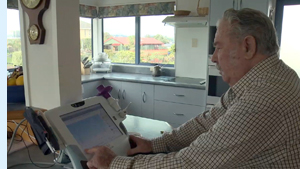 |
Ray Butler
|
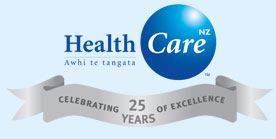 |
Telehealth monitoring for people with long-term conditions shows technology can improve quality of life and may have a positive impact on life expectancy.
Ray Butler would certainly agree – he has a new sense of hope about life with the lung disease asbestosis after taking part in a telehealth home monitoring trial.
“The condition hasn’t changed…but now with help, I feel I’ve got it under control and it’s not so scary.
I feel I can stay out of hospital and feel quite confident about the future.”
During the 12-month pilot, run by HealthCare of New Zealand in partnership with Lake Taupo Primary Health Organisation and Lakes DHB, telehealth monitors were set up in the homes of 10 Turangi/Taupo patients who have either chronic heart failure or chronic obstructive pulmonary disease.
The monitors enable patients to take their own vital sign measurements, including their blood pressure, blood sugars and lung capacity. These measurements are then assessed remotely by nurses, enabling medical teams to detect changes early, before the person develops a serious issue that needs hospital treatment.
Ray Butler says he was initially uncertain about the technology.
“When I started, I hadn’t had anything to do with computers, but after a bit of coaching, I soon mastered it.”
Compared with the control group, patients who used the technology experienced reduced hospital admissions and improved life expectancy. Of the original 10 participants of the non-telehealth group, four died during the pilot, compared with one person in the telehealth monitored group.
Patients who used telehealth also noted enhanced confidence, greater mental wellbeing, and an improved ability to manage their conditions.
The pilot's outcomes were assessed by independent research group Sapere in 2011, and are reinforced by large international studies, which show the effective use of telehealth can reduce unplanned hospital admissions.
Ray Butler is just happy to enjoy his new lease of life.
"When you have to go to hospital so many times, you can't help but get that feeling that time is running out. Now that (my asbestosis) appears to be under control and that I've got control – I've got a different outlook."
|
| |
|
| |
| |
NZULM & NZ Formulary
The New Zealand Universal List of Medicines (NZULM) and the New Zealand Formulary (NZF) continue to be well used by health professionals.
The NZULM provides the health and disability sector with an up-to-date, trusted, one-stop-shop of core and commonly used information about medicines from Medsafe and PHARMAC, based on a common medicines terminology, and will contribute to improved patient care.
It provides a foundation for the NZF, which offers concise, independent, evidence-based medicines information including indications, adverse reactions, interactions, pregnancy warning, cautionary advisory labels, consumer information and guidance on best practice for health professionals.
Prior to the 2010 launch of the NZULM, there were several different lists with their own descriptions used for prescribing and dispensing medicines. This had the potential to cause confusion for doctors, pharmacists and patients.
Shayne Hunter from the national eMedicines programme says the NZULM and NZF are improving medication management within the health and disability sector.
"This is about standardising the terms and information available to health professionals in order to minimise confusion and misunderstanding about the best medicines available to treat patients, and to provide valuable decision support and ensure optimal use of medicines and patient outcomes," he says.
NZULM is used widely by GPs and pharmacists, and a version tailored especially for hospitals – the Hospital Medicines List – will be launched later this year.
The NZF, meanwhile, has been well-received within the sector since its launch in 2011. Shayne Hunter says a version for children’s medicines will released later this year. For more information, go to www.nzformulary.org.nz.
|
|
|
Back to Top |
|
|
|
|
| |
|
 |
|
